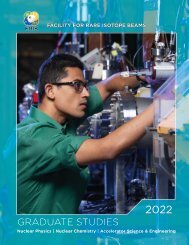2021FRIB/NSCL Graduate Brochure
You also want an ePaper? Increase the reach of your titles
YUMPU automatically turns print PDFs into web optimized ePapers that Google loves.
Paul Gueye<br />
Associate Professor of Physics<br />
Experimental Nuclear Physics<br />
Selected Publications<br />
D. Votaw et al., Shell inversion in the unbound<br />
N = 7 isotones, Phys. Rev., C102, 014325 (2020)<br />
MS, Physics, Université<br />
Cheikh Anta Diop,<br />
Senegal, 1990<br />
PhD, Physics,<br />
Université Clermont-<br />
Ferrand II, France, 1994<br />
Joined <strong>NSCL</strong> in<br />
September 2018<br />
gueye@nscl.msu.edu<br />
T. Redpath et al., New Segmented Target for<br />
Studies of Neutron Unbound Systems, Nucl.<br />
Inst. Meth. Phys. Res., A977, 164284 (2020)<br />
P. Guèye et al., Dispersive Corrections to the<br />
Born Approximation in Elastic Electron-Nucleus<br />
Scattering in the Intermediate Energy Regime,<br />
Eur. Phys. Jour. A56:126 (2020)<br />
S. B. L. Amar, O. Ka and P. Guèye, Meson Photo-<br />
Production in GEANT4 for Ev = 0.225–3.0 GeV<br />
using the y+ p yp+ π0 reaction, Eur. Phys. J. A<br />
55:62 (2019)<br />
D. Abbott et al., Production of Highly Polarized<br />
Positrons Using Polarized Electrons at MeV<br />
Energies, PRL 116, 214801 (2016)<br />
The nucleus of the simplest atom (hydrogen) is composed<br />
of a single proton. With the addition of one neutron, a<br />
heavier hydrogen (deuteron) atom can be formed but this is<br />
also when nucleon-nucleon interactions start to occur inside<br />
nuclei. How does nature went from hydrogen to heavier<br />
elements? How do nucleons interact? What happens when<br />
many more nucleons are packed into a small pace? What if<br />
there are more neutrons than protons (or vice versa) and<br />
how to make them? These and many more questions are<br />
vitals to our understanding of the universe.<br />
My research interest is in experimental nuclear physics with<br />
a focus on neutron-rich isotopes along the neutron dripline.<br />
I am a member of the MoNA Collaboration that has a long<br />
history of studying the properties of neutron-unbound<br />
nuclei. We probe their formation and unravel their nuclear<br />
structures. This research provides important insights into<br />
the nucleon–nucleus interaction far from stability, the<br />
coupling to the continuum in neutron-rich systems, and the<br />
structure of multi-neutron halos or skins.<br />
We use the invariant mass spectroscopy as the primary<br />
technique to probe resonance states using the 4-momenta<br />
of the neutron rich decay products (fragments and<br />
neutrons). There are two devices uniquely suited to conduct<br />
my research: the MoNA-LISA modular neutron array (288<br />
plastic scintillators bars of 10x10x200 cm 3 ) and a 4 Tm large<br />
gap superconducting sweeper magnet. We also constructed<br />
a Be-Si segmented target that improves greatly our energy<br />
resolution using position-sensitive silicon detectors and<br />
permits to increase the effective length of (passive) reaction<br />
targets to unravel processes with very low probabilities. This<br />
expertise was utilized to develop a new Si-CsI telescope<br />
to identify heavy ions from their energy loss (Si) and total<br />
energy (CsI) to enable a new complementary sweeperless<br />
experimental scientific program.<br />
I am also utilizing my expertise from electron scattering to<br />
enhance our existing research thrusts by: (i) designing and<br />
testing a highly segmented GEM (gas electron multiplier)-<br />
based active target that houses several thin (250-500 μm)<br />
beryllium foils for the detection of low energy recoils to<br />
enable the missing mass technique for additional insights<br />
into the reaction mechanisms and dynamics of neutron-rich<br />
nuclei; (ii) developing the next generation neutron detectors<br />
to provide unprecedented position (100s μm) and timing<br />
(tens of ps) resolution to upgrade the MoNA-LISA array for<br />
the upcoming Facility for Rare Isotope Beams; (iii) building<br />
a GEANT4 Monte Carlo simulation general framework<br />
to study neutron-rich nuclei; and (iv) investigating the<br />
possibilities of polarized targets to study spin dependent<br />
observables for rare isotope research.<br />
34<br />
KEYWORDS<br />
Neutron Dripline | Nuclear Structure | MoNA-LISA<br />
Weakly-Bound Nuclear Systems<br />
Scientific discoveries require a diverse pool of students<br />
each with their unique talents and abilities. My group is<br />
reflective of my passion to provide exciting opportunities<br />
for students from multi-disciplinary background interested<br />
in gaining some knowledge and contributing to basic and<br />
applied nuclear physics fields.






